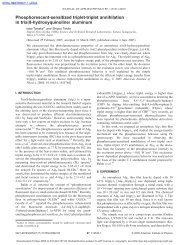Children's Television: Trends Around the World
Children's Television: Trends Around the World
Children's Television: Trends Around the World
You also want an ePaper? Increase the reach of your titles
YUMPU automatically turns print PDFs into web optimized ePapers that Google loves.
CHILDREN’S TELEVISION: TRENDS AROUND THE WORLD<br />
109<br />
<strong>the</strong>ir reputation as <strong>the</strong> “heart” of U.S. television—began to place greater importance<br />
on children’s programs from <strong>the</strong> mid-1980s. A variety of program genres<br />
was developed, including literacy and story programs, programs encouraging<br />
scientific and ma<strong>the</strong>matical thinking and new programs for preschoolers, in<br />
addition to <strong>the</strong> well-known Sesame Street. Public broadcasting also looked<br />
ahead to <strong>the</strong> digital age, and began developing program-driven websites and<br />
interactive television. In September 1999, when PBS went digital, <strong>the</strong> first channel<br />
to be launched was a 24-hour children’s channel, PBS Kids Channel.<br />
The United Kingdom<br />
In <strong>the</strong> midst of <strong>the</strong> debate about children’s television ensuing from <strong>the</strong> aforementioned<br />
survey, <strong>the</strong> world’s first terrestrial digital broadcasting service was<br />
introduced in <strong>the</strong> United Kingdom, and <strong>the</strong> possibility of launching a BBC<br />
children’s television channel was frequently discussed. At first, in addition to<br />
children’s programs aired on <strong>the</strong> channels BBC1 and BBC2, many children’s<br />
programs were broadcast on <strong>the</strong> digital channel, BBC Choice (now, BBC3).<br />
In February 2002, a full-fledged children’s service was formally introduced,<br />
consisting of two channels: CBBC, catering for age 6 to 12, and CBeebies,<br />
catering to preschoolers. Both are dominated by British-made programs in a<br />
variety of formats, all attuned to British culture. CBBC was launched with <strong>the</strong><br />
motto, “learning through fun,” and CBeebies with “learning through play.”<br />
CBBC broadcasts from 7 A.M. to 7 P.M.; CBeebies from 6 A.M. to 7 P.M.<br />
As early as its first year (as of October 2002), CBeebies was <strong>the</strong> most<br />
viewed of all 17 children’s channels available in <strong>the</strong> United Kingdom. CBBC<br />
was <strong>the</strong> tenth most viewed channel in its first year. By <strong>the</strong> following year, it<br />
had climbed to fifth place. 8<br />
O<strong>the</strong>r Countries<br />
O<strong>the</strong>r children’s channels are emerging all over <strong>the</strong> world, such as Italy’s<br />
RaiSat Ragazzi (launched in 1999), Sweden’s Barnkanalen (launched in<br />
2002), and Australia’s ABC Kids and Fly TV (both launched in 2001, but<br />
closed down in 2003).<br />
With digitization, new developments have also occurred outside <strong>the</strong> realm<br />
of public television. For example, established children’s channels such as<br />
Nickelodeon and Disney Channel have launched new channels especially for<br />
preschoolers and to broadcast exclusively cartoons (see Figure 1). Notable<br />
among <strong>the</strong>se are NOGGIN and Nick Jr., launched by Nickelodeon for viewing<br />
Commercial TV Channels for Children up to Twelve Years Old,” European Journal of<br />
Communication 28 (2003), pp. 33–52.<br />
8 See European Broadcasting Union data from households with digital television and children<br />
of age 4 to 15, November 2003.







